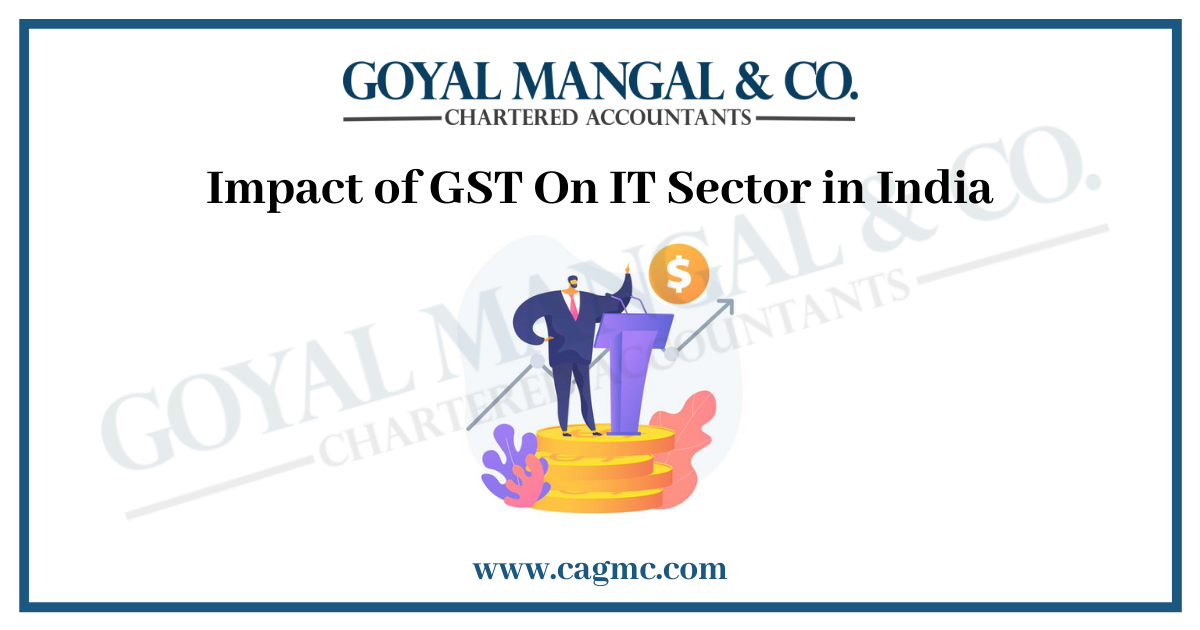IT industry is one of the sectors which is impacted by the implementation of GST in India. Prior to the GST regime, the tax system in India was complicated because of multiple taxes, many compliance obligations, and tax cascading. In GST regime, the complicated system converted into a simpler tax regime, especially for the IT sector.
Because of the financial independence of the States and the Centre, the Government applied a dual GST structure i.e., Central GST and State GST at each stage of the supply chain. Mostly Information Technology services fall under the category of 18% slab rate.
|
Table of Content: |
What does GST mean?
GST stands for Goods, services, and tax. It is an indirect tax that will replace the different state and centre taxes. This will take the form of a single and uniform tax. There are many sectors that had to go through more than 2-3 taxes, but after the implementation of GST, there is only one tax. The main purpose of GST is to rationalize the current indirect tax regime, which will provide a stable economic environment favourable for growth and development.
Previous Tax Regime on Information and Technology Sector (IT Sector)
Under previous tax regime the sale of packaged software is associated to both VAT and service tax. VAT rate is basically 5% in most of the states and Service tax rate is 15%. Excise duty is also levied in case of manufacturing of IT products.
For Example, if software comes in a CD or DVD or Hard disk, then there are 3 taxes that are included namely: –
- Excise Duty for manufacturing of product.
- Sales tax i.e. VAT for sale.
- Service Tax for providing Service as software can be downloadable for numerous times

Impact of GST on the Indian IT Sector
The following significant changes have been witnessed on the Indian IT Sector due to GST
1.Registration:
From April 1st July after the GST come into force, all the traders require to take registration in each state for their business. Under old tax regime, all the Service Providers were registered under Central Service Tax department and all billing matters, utilization of credit are assessed from a single location.
Under GST regime, big IT Service Providers like MNC have to face practical difficulties as the GST Registration and other statutory provisions to be taken care for each location separately.
2. Tax Rate of IT Industry:
Under the old tax regime, overall rate of indirect taxes is come under 20 to 25 %(including excise duty, VAT, service Tax etc.), and GST rate come under 18% due to this price of IT products may cost you cheaper but for IT services, you have to pay high rates.
3. Avail ITC:
When there is a significant increase in infrastructure and overhead costs for businesses, they can take benefit in form of ITC. Under old regime, traders on selling goods (paying output VAT) earlier could not claim service tax paid on AMCs {Annual Maintenance Service) contracts for their computers and software. Under GST, they can take ITC for the same. For example, Deepika sells fruit drinks worth Rs. 10,000. She also has to pay an AMC of Rs. 1000 per month on the computers used in his offices.
| Particulars | Before GST | After GST |
| Sale of juice | 10000 | 10000 |
| [email protected]% | 1450 | |
| GST@12% | 1200 | |
| AMC Contract | 1000 | 1000 |
| Input tax on AMC | ||
| Service tax@15% | 150 | |
| GST@18% | 180 | |
| Total tax outflow | {1450+150}
1600 |
1020 |
4.Redesigning Business Software:
In Mostly cases, the ERP software that were provided by the IT majors have to be redesigned and updated with the new GST rules. Companies are mainly upgrading their enterprise resource planning (ERP)system and accounting software to adapt the complexities of calculating GST. Either they have to upgrade their existing software based on old tax regime to the new version or use specific GST software.
5.Software Developers and Sellers:
There is a race for all companies to develop a GST software. GST will impact these companies positively. Demand for GST software by all the companies will result in a huge boost to the software developers.
6.No Cascading Effect of Taxes:
Under Present taxation regime, IT Service Providers are not eligible to claim the tax credit and every time tax is charged on accumulated amount.
And as per the GST regime, both IT Service Providers and clients are entitled to claim tax credit which leads to no cascading effect.
Export of Services
Export of information technology is an important source of foreign exchange, with India being the biggest exporter of IT services. Exports are zero-rated and input taxes paid will be allowed as a refund. The default rule for place of supply (export of service) is the location of the service recipient if the address of the recipient is available. So, exporters must ensure that the address of service recipient can be presented before the authorities on request. The typical IT/ ITES services which come under the default rule will be software development, BPO operations, software consultancy, etc. Apart from these, this rule will also apply to other services like software support/ maintenance and intermediary services as there are no exceptions under GST.
Conclusion
GST has introduced an increased tax rate of 18% for most of IT services. It results in increase in the cost of implementation, but it will definitely have a positive impact in the long-term. Factors like availability of ITC, no GST on exports, and removal of tax cascading effect will definitely bring the cost down and increase the overall benefits of the IT sector in India.


